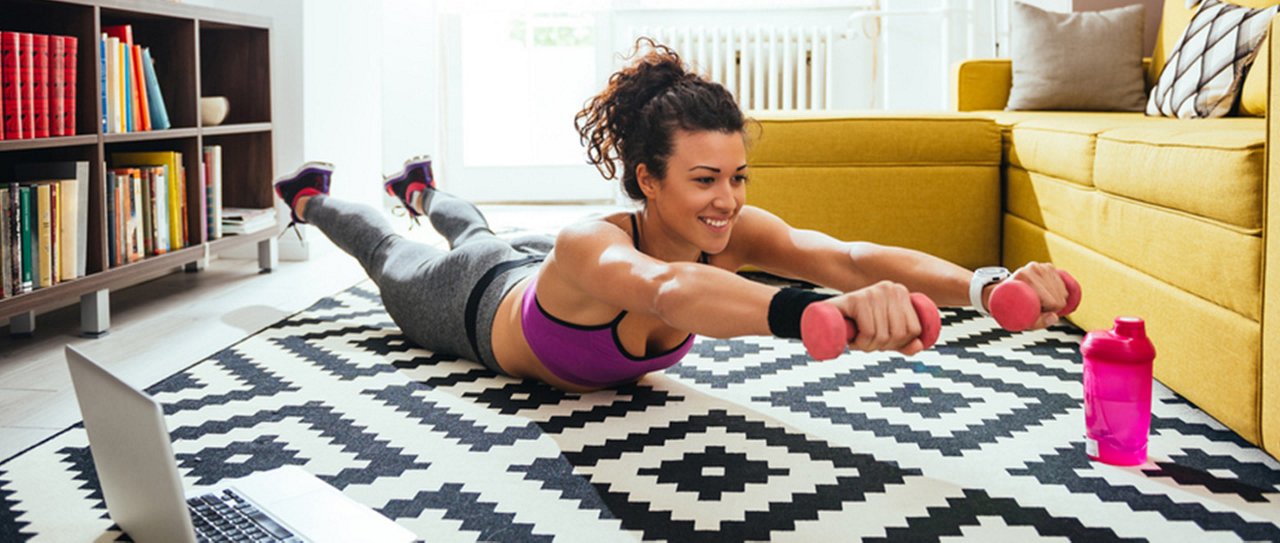8 ways to stick with exercise and a healthy diet at home

Do you find yourself ditching healthy habits when you’re at home, even if you didn’t intend to? Can’t get to the gym, so you don’t work out. There are goodies in the pantry and pizza delivery is just a text away. Being at home can be a minefield of temptation.
And then, because you’re thinking you've blown your diet or skipped workouts anyway, you just keep going with the free-for-all. When that happens, chances are good that you might not go back to it. On top of that, yo-yo dieting can play havoc with your metabolism over time, making it even harder to lose weight.
But it doesn’t have to be that way. With some planning and preparation – and perhaps a mindset shift – you can stay on track at home.
Your winning strategy
1. Move your body every day
Make time to exercise, even if it’s a short amount. Our bodies were made to move.
Plan your exercise by scheduling a specific time each day to work out or go for a walk.
If you don’t feel like doing it, commit to at least five minutes. Chances are, once you start you won’t stop there. Getting started is the hardest part.
If working from home, set a timer to ensure that you get up to walk around and stretch at least every hour. You can even exercise from your living room couch.
2. Unplug and go outdoors
It doesn’t have to be an iron-pumping workout to count as exercise. You can fit in activities with your family. Anything that gets you up and moving is good.
For example:
- Walk in your neighborhood or at a park. Walking the dog is a great way to do this.
- Go for a bike ride.
- Play ball in the yard with the kids.
- Do yard work.
- Craving some alone time? Go outside for a stress-busting run or power walk.
Whatever activity you choose, your body, mind and spirit will benefit from the exercise, fresh air and sunshine.
3. Make a food plan
To save time (and to cut out the temptation to hang out in the bakery aisle), do your grocery shopping order online if you can. This frees up time to plan your meals and prep for the week.
If you’re cooking ahead, freeze some of the meals so you don’t run out at the end of the week.
If meal prepping just isn’t your thing, you might try one of the ingredient-and-recipe meal kit delivery services which have become popular.
Why take the time to plan or prep? Because when you have ready-made nutritious meals at home, you won’t be as tempted to grab unhealthy fast food. You’ll save calories and money.
Limit take-out, and cook at home instead. Even if you only make a few dinners a week, you’ll still be coming out ahead.
4. Think moderation, not deprivation
Learn to practice moderation and portion control so that you can still enjoy the food and drinks you love.
Watch your alcohol, sodas and snacks. For example, it’s easy to overeat while you’re enjoying a movie or game. Four cans of beer (620 calories), four slices of stuffed-crust pizza (1,520 calories), and one cup of peanuts (828 calories) adds up to almost 3,000 calories! Instead, you could limit the beer and pizza to one or two, and have a lower-calorie crunchy snack like popcorn instead of peanuts.
5. Don’t keep tempting treats around
Leaving it out on the kitchen counter where you’re constantly seeing it, or anywhere that’s too easily accessible, only leads to overeating. You’re only human. Better yet, don’t bring junk food home at all. Keep your fridge and pantry stocked with healthier options, and fruit on the counter.
Boredom, loneliness and stress can be powerful triggers to over-snack. Distraction and keeping busy with a project can help you fight the urge to engage in mindless eating.
6. Get enough rest
Research has shown that lack of sleep can make you hungrier. It increases levels of the hunger hormone ghrelin, while lowering levels of the appetite suppressor hormone leptin. And, cortisol levels rise if you don’t get enough sleep – a stress hormone associated with abdominal fat increase.
Don’t feel guilty about taking time to relax. It’s important to recharge, for your well-being.
7. Rethink dieting
If you’re having difficulty staying on track, ask yourself if your plan is too restrictive. Maybe it’s not the right one for you. Perhaps that’s the reason you’re having trouble.
Fad diets and those that promise rapid weight loss may help you drop a few pounds in the short term, but if you can’t stick with it because you’re hungry all the time, not getting the nutrition your body needs, or because you can’t have the foods you want, then what good is it?
Dieting can easily lead to overeating or even bingeing when you’re inevitably not able to stay on it. That can wreck your health as well as your waistline.
Instead, focus on nutrition and on sustainable healthy lifestyle choices that you can actually keep up with on a daily basis, rather than being on or off of a diet.
One method that works for many people is the 80/20 principle: Sticking to your plan of exercising and eating healthy foods at least 80% of the time. This helps you practice balance and moderation while incorporating healthy habits into your lifestyle in a more doable way than a strict plan.
Just as with exercise, when it comes to diet it’s important to find what you like, what you can live with long term, and what works for you.
8. Enlist help if needed
If you have been struggling on your own, consider working with a qualified professional. Many work with clients remotely using videoconferencing.
- A registered dietitian can develop a nutrition plan that uniquely fits you, and provide support.
- A certified personal trainer can create a personalized exercise program and work with you one-on-one to help you reach your goals and avoid injury.
- If you think you might be experiencing disordered eating, seek out a licensed therapist who specializes in this area. There’s no need to suffer in silence.
Access nutrition and other counseling services by calling the number on the back of your member ID card or use Find A Doctor to locate a provider.
Find what works for you
Above all, don’t give up on trying to improve your health and fitness
It can take time, and some trial and error, to find the right balance that fits. Keep going, get support if you need it, and do what works for you.
Browse related articles


Blue Cross and Blue Shield of North Carolina does not discriminate on the basis of race, color, national origin, sex, age or disability in its health programs and activities. Learn more about our non-discrimination policy and no-cost services available to you.
Information in other languages: Español 中文 Tiếng Việt 한국어 Français العَرَبِيَّة Hmoob ру́сский Tagalog ગુજરાતી ភាសាខ្មែរ Deutsch हिन्दी ລາວ 日本語
© 2024 Blue Cross and Blue Shield of North Carolina. ®, SM Marks of the Blue Cross and Blue Shield Association, an association of independent Blue Cross and Blue Shield plans. All other marks and names are property of their respective owners. Blue Cross and Blue Shield of North Carolina is an independent licensee of the Blue Cross and Blue Shield Association.



